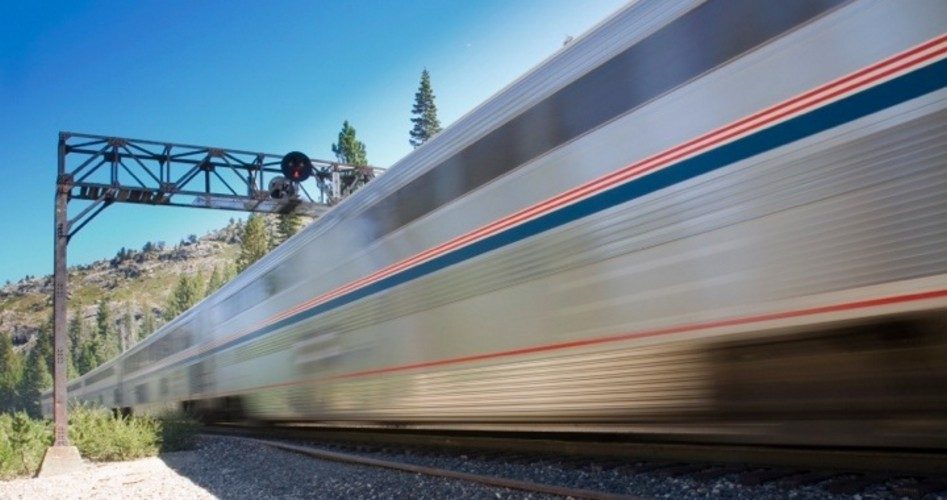
Today is our lucky day, the day each year my wife and I get to be on the receiving end of multiple doses of federal welfare — gratis money we didn’t ask for and don’t need that will be picked from taxpayers’ pockets in order to lower the price of our breakfast, dinner, travel, and unlimited pours of pinot noir and chardonnay.
As I’m writing this, an Amtrak attendant is driving our ruby red Lexus ES350 up the ramp onto Amtrak’s Auto Train in Lorton, Virginia (near Washington, D.C.), for our overnight train excursion to Sanford, Fla. (near Orlando).
Before it headed off to the loading area, another Amtrak attendant slowly circled our car with a video camera, carefully filming the condition of every panel so there’ll be clear evidence when we arrive in Florida whether a scratch or dent was a preexisting condition.
Generally stretching about three-quarters of a mile in length, the Auto Train is often said to be the longest passenger train in the world, counting the enclosed freight cars transporting the cars, vans, motorcycles, jet skis, limos, hot rods, SUVs and small boats. Purist, conversely, maintain the Auto Train is a mixed-use conglomeration of freight and passengers rather than an unalloyed passenger train.
In any case, regarding train subsidies and taxpayers’ costs, Fred Frailey reported in the November 2013 issue of Trains magazine in his “Amtrak’s fiscal report card for 2013” column that Amtrak’s operating losses were $1.2 billion in fiscal 2013, a jump of $28 million in losses over fiscal 2012.
Amtrak’s biggest losses occurred with the long-distance passenger trains. The Chicago-to-Oakland Zephyr lost a whopping $74 million in 2013. Altogether, long-distance passenger trains lost $627 million in fiscal 2013, slightly more than half of Amtrak’s total losses last year, and up $37 million in red ink from 2012.
The Lorton-to-Sanford Auto Train that we’re riding loses 14 cents per passenger mile. For the 1,710-mile round trip, that’s a loss of $239.40 per passenger. For two of us, that’s a $478.80 federal subsidy per trip.
To kick off the trip, there’s a daily 4 p.m. complimentary wine-and-cheese party for sleeper-car passengers while the crew is connecting the train’s passenger cars to the vehicle-carrying rail cars.
The Auto Train’s wine-and-cheese party, along with complimentary wine parties offered to sleeper-car passengers on three other long-distance routes, cost Amtrak $428,000 in 2012, according to Amtrak’s Inspector General Theodore Alves.
Amtrak loses another $260,000 or so per year in its food operation, according to Alves, by way of providing free meals to Amtrak’s employees who are enjoying free rides on the rails via employee freebie travel passes.
With a reserved seating in the dining car at 5, 7 or 9 p.m. and a nice rose (plastic, but realistic) on the table, our dinners were included in the price of our sleeper-bedroom ticket. Inspector General Alves estimated in testimony in November 2013 to the House Oversight and Government Reform Committee that Amtrak’s food service losses were $72 million in 2013, with almost all of the losses due to providing meals on long-distance trains.
The $72 million, unfortunately, might hugely understate the losses, according to the chairman of the Government Operations Subcommittee, Rep. John Mica, R-Fla. “The Amtrak inspector general has confirmed,” said Mica, “that Amtrak cooked the books to cover up food service losses that now approach $1 billion.”
If everything goes all right after we’ve been rocked back and forth to sleep all night in our bunk beds, we’ll hear a wake-up announcement on the intercom stating that a complimentary breakfast of bananas, oranges, cereals, bagels, muffins, milk, orange juice and coffee will be served in the dining car starting at 6:00 a.m. and we’ll be arriving at the Sanford station around 9 a.m.
Endpoint to endpoint, the Auto Train runs at an average speed of 49 mph — a third of the 150 mph top speed of Amtrak’s Acela in the Northeast Corridor and a sixth of Japan’s 300 mph passenger trains.
Note to our central planners in government budgeting who seem unable to reduce Amtrak’s rising levels of red ink in its food operations: We’d eat and drink less per trip if the trains doubled or tripled their speed.
Ralph R. Reiland is an associate professor of economics and the B. Kenneth Simon professor of free enterprise at Robert Morris University in Pittsburgh.



